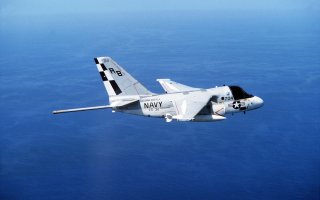This U.S. Navy Jet Hunted Russian Submarines (and More)
The S-3A entered operational service in 1974 with VS-41, and soon each carrier had its own squadron of the antisubmarine planes.
Take, for example, the carrier air wing’s reliance on Super Hornet fighters to serve as air-refueling tankers. While it is to the Super Hornets credit that it can perform this role, it is hardly an optimal use of the flight-hours of a high-performance fighter plane. Furthermore, a Super Hornet tanker cannot carry as much fuel as a dedicated tanker.
In fact, missile-equipped Vikings would have slightly less than twice the combat radius of a Super Hornet equipped with extra fuel tanks. Of course, the Viking is not an airplane that wants to get to close to well-defended airspace, but it might still offer carrier air wings a useful capability for delivering stand-off attacks at much greater range.
Finally, there is the matter of the antisubmarine mission, which has no fixed-wing replacement onboard American carriers. While Navy SH-60 Seahawk helicopters provide antisubmarine protection, they can only operate over fairly short distances at low speeds, suitable for close protection rather than large area patrols. Long-distance patrol duties are now confined to large P-3 and P-8 maritime patrol planes, which operate from bases on land. This means the carriers can only make limited contributions to the antisubmarine mission, even though we live in a time when cheap and effective submarines are proliferating to an unprecedented degree in the Pacific, and submarines have repeatedly succeeded in slipping through defenses to sink carriers in naval exercises.
The Viking provided valuable service to the U.S. Navy by virtue of its very long range and adaptability to a wide variety of roles. It could likely have gone on doing so for many more years if newer, more expensive and more limited alternatives had not displaced it.
Sébastien Roblin holds a master’s degree in conflict resolution from Georgetown University and served as a university instructor for the Peace Corps in China. He has also worked in education, editing and refugee resettlement in France and the United States. He currently writes on security and military history for War Is Boring.
This article first appeared several years ago.
Image: Wikimedia Commons


